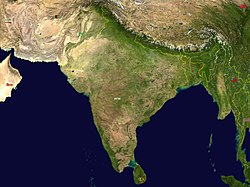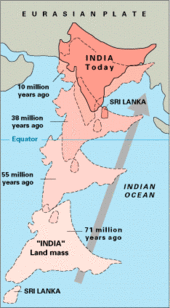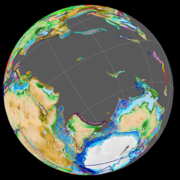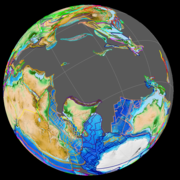Indijski potkontinent
 Geopolitička karta indijskog potkontinenta | |
| Države | |
|---|---|
| Jezici | Zvanični jezici |
| Najveći gradovi | |

Indijski potkontinent se može smatrati velikim poluostrvom Azije, koje se se u obliku trougla prostire duboko na jug ka Indijskom okeanu. Potkontinentom se naziva zbog toga što je nekada bio sastavni deo Gondvane, koji se odvojio i spojio sa Azijom. Većinu ovog potkontinenta zauzima visoravan Dekan, visine oko 500 metara. Na severu ove visoravi je planina Vinđa, a na istoku i zapadu su planine Istočni i Zapadni Gati. Zapadni Gati doistižu visinu od 2.700 metara nadmorske visine. Na krajnjem jugu poluostrva je rt Komorin. Na zapadu, obala prema Arapskom moru obuhvata obalu Konkani i Malabarsku obalu. Na istoku je Bengalski zaliv. Uglavnom obuhvata zemlje Bangladeš, Butan, Indija, Maldivi, Nepal, Pakistan i Šri Lanka.[1][2][3][4][5][6] Termini Indijski potkontinent i Južna Azija se ponekad koriste naizmenično za označavanje regiona, iako geopolitički termin Južna Azija često uključuje Avganistan,[7] a ponekad čak i Britansku teritoriju Indijskog okeana. Geošema Ujedinjenih nacija za Aziju takođe uključuje Iran u južnoj Aziji.
Geološki, Indijski potkontinent je povezan sa kopnom koje se odvojilo od superkontinenta Gondvane tokom krede i spojilo se sa evroazijskim kopnom pre skoro 55 miliona godina.[8] Geografski, to je poluostrvo u južnoj-centralnoj Aziji, omeđeno Himalajima na severu, Hindukušom na zapadu i Arakanezom na istoku.[9] Susedni geografski regioni oko potkontinenta uključuju Tibetansku visoravan na severu, Indokinesko poluostrvo na istoku i Persijsku visoravan (ili Veliki Iran) na zapadu.
Ime[uredi | uredi izvor]
Prema Oksfordskom rečniku engleskog jezika, termin potkontinent označava „podeljenje kontinenta koje ima poseban geografski, politički ili kulturni identitet“ i takođe „veliku kopnenu masu nešto manju od kontinenta“.[10][11] Njegova upotreba za označavanje indijskog potkontinenta je evidentirana od ranog dvadesetog veka kada je većina teritorije bila deo Britanske Indije,[12][13][14] jer je to bio pogodan termin za označavanje regiona koji obuhvata Britansku Indiju i kneževske države pod britanskom vrhovnom vlašću.[15][16]
Indijski potkontinent kao termin je bio posebno uobičajen u Britanskoj imperiji i njenim naslednicima,[17] dok je termin Južna Azija češća upotreba u Evropi i Severnoj Americi.[18][19] Prema istoričarima Sugata Bose i Aješa Jalal, indijski potkontinent je postao poznat kao Južna Azija „u novijem i neutralnom jeziku“.[20] Indolog Ronald B. Inden tvrdi da upotreba termina Južna Azija postaje sve raširenija, budući da jasno razlikuje region od Istočne Azije.[21] Dok Južna Azija, tačniji termin koji odražava savremena politička razgraničenja regiona, zamenjuje Indijski potkontinent, termin koji je usko povezan sa kolonijalnim nasleđem regiona, kao naslovni termin, ovaj drugi se još uvek široko koristi u tipološkim studijama.[22][23]
Od podele Indije, građani Pakistana (koji je postao nezavisan od Britanske Indije 1947. godine) i Bangladeša (koji je postao nezavisan od Pakistana 1971. godine) često doživljavaju upotrebu Indijskog potkontinenta kao uvredljivu i sumnjivu zbog dominantnog položaja Indije u nazivu. Kao takav se sve manje koristi u tim zemljama. U međuvremenu, mnogi indijski analitičari radije koriste ovaj termin zbog socio-kulturnih sličnosti u regionu.[24] Region je takođe nazivan „Azijski potkontinent“,[25][26] „Južnoazijski potkontinent“,[27][28][29] kao i „Indija“ ili „Velika Indija“ u klasičnom i pre-modernom smislu.[7][30][31]
Geologija[uredi | uredi izvor]

Indijski potkontinent je ranije bio deo Gondvane, superkontinenta formiranog tokom kasnog neoproterozoika i ranog paleozoika.[8] Gondvana je počela da se raspada tokom mezozoika, sa indijskim potkontinentom koji se odvojio od Antarktika pre 130-120 miliona godina[32] i Madagaskara pre oko 90 miliona godina[33] tokom krede. Indijski potkontinent se kasnije povukao ka severoistoku, sudarajući se sa Evroazijskom pločom pre skoro 55 miliona godina, pred kraj paleocena.[8] Zona u kojoj se spajaju evroazijska i indijska potkontinentna ploča ostaje geološki aktivna, sklona velikim zemljotresima.[34][35]
Fiziografski, to je poluostrvo u južnoj centralnoj Aziji omeđeno Himalajima na severu, Hindukušom na zapadu i Arakanezom na istoku.[9][36] Proteže se na jug u Indijski okean sa Arabijskim morem na jugozapadu i Bengalskim zalivom na jugoistoku.[1][37] Veći deo ovog regiona počiva na Indijskoj ploči i izolovan je od ostatka Azije velikim planinskim barijerama.[38] Lakadivska ostrva, Maldivi i arhipelag Čagos su tri niza koralnih atola, kejeva i ostrva na indijskoj ploči zajedno sa grebenom Čagos-Lakadiv, podmorskim grebenom koji je nastao severnim nanošenjem Indijske ploče preko žarišta Rejunjon tokom ere krede i ranog kenozoika.[39][40][41] Maldivski arhipelag se uzdiže iz osnove vulkanskih bazaltnih izliva sa dubine od oko 2000 m čineći centralni deo grebena između Lakadiva i Velikog Čagos spruda.[41]
Reference[uredi | uredi izvor]
- ^ a b "Indian subcontinent". New Oxford Dictionary of English (ISBN 0-19-860441-6) New York: Oxford University Press, 2001; p. 929: "the part of Asia south of the Himalayas which forms a peninsula extending into the Indian Ocean, between the Arabian Sea and the Bay of Bengal. Historically forming the whole territory of Greater India, the region is now divided into three countries named Bangladesh, India and Pakistan."
- ^ Dhavendra Kumar (2012). Genomics and Health in the Developing World. Oxford University Press. str. 889. ISBN 978-0-19-537475-9.
- ^ Mariam Pirbhai (2009). Mythologies of Migration, Vocabularies of Indenture: Novels of the South Asian Diaspora in Africa, the Caribbean, and Asia-Pacific. University of Toronto Press. str. 14. ISBN 978-0-8020-9964-8.
- ^ Dhavendra Kumar (2012). Genomics and Health in the Developing World. Oxford University Press. str. 889. ISBN 978-0-19-537475-9. Arhivirano iz originala 21. 2. 2018. g. Pristupljeno 9. 12. 2016. „India, Pakistan, Bangladesh, Sri Lanka, Nepal, Bhutan and other small islands of the Indian Ocean”
- ^ John McLeod, The history of India, page 1, Greenwood Publishing fGroup, 2002, ISBN 0-313-31459-4
Stephen Adolphe Wurm, Peter Mühlhäusler & Darrell T. Tryon, Atlas of languages of intercultural communication in the Pacific, Asia, and the Americas, pages 787, International Council for Philosophy and Humanistic Studies, Published by Walter de Gruyter, 1996, ISBN 3-11-013417-9
Haggett, Peter (2001). Encyclopedia of World Geography (Vol. 1). Marshall Cavendish. str. 2710. ISBN 0-7614-7289-4. - ^ "the Indian Subcontinent occupies the major landmass of South Asia" John R. Lukacs, The People of South Asia: the biological anthropology of India, Pakistan, and Nepal, page 59, Plenum Press, 1984, ISBN 9780306414077. "the seven countries of South Asia constitute geographically a compact region around the Indian Subcontinent".
Tatu Vanhanen, Prospects of Democracy: A Study of 172 Countries, page 144, Routledge, 1997, ISBN 9780415144063 - ^ a b John McLeod, The history of India, page 1, Greenwood Publishing Group, 2002, ISBN 0-313-31459-4; note: McLeod does not include Afghanistan in Indian subcontinent or South Asia;
Jim Norwine & Alfonso González, The Third World: states of mind and being, pages 209, Taylor & Francis, 1988, ISBN 0-04-910121-8 Quote: ""The term "South Asia" also signifies the Indian Subcontinent""
Raj S. Bhopal, Ethnicity, race, and health in multicultural societies, pages 33, Oxford University Press, 2007, ISBN 0-19-856817-7; Quote: "The term South Asian refers to populations originating from the Indian subcontinent, effectively India, Pakistan, Bangladesh and Sri Lanka;
Lucian W. Pye & Mary W. Pye, Asian Power and Politics, pages 133, Harvard University Press, 1985, ISBN 0-674-04979-9 Quote: "The complex culture of the Indian subcontinent, or South Asia, presents a tradition comparable to Confucianism."
Mark Juergensmeyer, The Oxford handbook of global religions, pages 465, Oxford University Press US, 2006, ISBN 0-19-513798-1
Sugata Bose & Ayesha Jalal, Modern South Asia, pages 3, Routledge, 2004, ISBN 0-415-30787-2 - ^ a b v Robert Wynn Jones (2011). Applications of Palaeontology: Techniques and Case Studies. Cambridge University Press. str. 267—271. ISBN 978-1-139-49920-0.
- ^ a b Baker, Kathleen M.; Chapman, Graham P. (11. 3. 2002), The Changing Geography of Asia, Routledge, str. 10—, ISBN 978-1-134-93384-6, „This greater India is well defined in terms of topography; it is the Indian sub-continent, hemmed in by the Himalayas on the north, the Hindu Khush in the west and the Arakanese in the east.”
- ^ Webster's Third New International Dictionary, Unabridged, Merriam-Webster, 2002. Retrieved 6 December 2016; Quote: "a large landmass smaller than a continent; especially: a major subdivision of a continent ! e Indian subcontinent | "
- ^ Subcontinent Arhivirano na sajtu Wayback Machine (30. avgust 2017), Oxford English Dictionaries (2012). Retrieved 6 December 2016; Quote: "A large distinguishable part of a continent..."
- ^ McLeod, John (1. 1. 2002). The History of India. Greenwood Publishing Group. ISBN 9780313314599 — preko Google Books.
- ^ Milton Walter Meyer, South Asia: A Short History of the Subcontinent, pages 1, Adams Littlefield, 1976, ISBN 0-8226-0034-X
- ^ "Indian subcontinent" is used by Henry D. Baker, British India With Notes On Ceylon Afghanistan And Tibet (1915), p. 401.
- ^ „subcontinent”. Oxford English Dictionary (3rd izd.). Oxford University Press. septembar 2005. (Potrebna je pretplata ili članska kartica javne biblioteke UK.)
- ^ „Indian subcontinent”. Oxford English Dictionary (3rd izd.). Oxford University Press. septembar 2005. (Potrebna je pretplata ili članska kartica javne biblioteke UK.)
- ^ Milton Walter Meyer, South Asia: A Short History of the Subcontinent, pages 1, Adams Littlefield, 1976, ISBN 0-8226-0034-X
Jim Norwine & Alfonso González, The Third World: states of mind and being, pages 209, Taylor & Francis, 1988, ISBN 0-04-910121-8
Boniface, Brian G.; Christopher P. Cooper (2005). Worldwide destinations: the geography of travel and tourism. Butterworth-Heinemann. ISBN 978-0-7506-5997-0.
Judith Schott & Alix Henley, Culture, Religion, and Childbearing in a Multiracial Society, pages 274, Elsevier Health Sciences, 1996, ISBN 0-7506-2050-1
Raj S. Bhopal, Ethnicity, race, and health in multicultural societies, pages 33, Oxford University Press, 2007, ISBN 0-19-856817-7
Lucian W. Pye & Mary W. Pye, Asian Power and Politics, pages 133, Harvard University Press, 1985, ISBN 0-674-04979-9
Mark Juergensmeyer, The Oxford handbook of global religions, pages 465, Oxford University Press US, 2006, ISBN 0-19-513798-1
Sugata Bose & Ayesha Jalal, Modern South Asia, pages 3, Routledge, 2004, ISBN 0-415-30787-2 - ^ Judith Schott & Alix Henley, Culture, Religion, and Childbearing in a Multiracial Society, pages 274, Elsevier Health Sciences, 1996, ISBN 0750620501
- ^ Raj S. Bhopal, Ethnicity, race, and health in multicultural societies, pages 33, Oxford University Press, 2007, ISBN 0198568177
- ^ Sugata Bose & Ayesha Jalal, Modern South Asia, pages 3, Routledge, 2004, ISBN 0415307872
- ^ Ronald B. Inden, Imagining India, page 51, C. Hurst & Co. Publishers, 2000, ISBN 1850655200
- ^ Tom McArthur, Oxford Guide to World English, page 309, Oxford University Press, 2003, ISBN 9780198607717
- ^ Raymond Hickey (ed), Standards of English: Codified Varieties around the World, page 256, Cambridge University Press, 2012, ISBN 9781139851213
- ^ B.H. Farmer, An Introduction to South Asia, page 1, Methuen and Co. Ltd., 1983, ISBN 9780416726008, "The 'Indian sub continent' is a term that certainly recognises the dominant position of India in both area and population. Since the partition of Indian Empire, use of this term becomes offensive to the Pakistanis and the Bangladeshis."
Jona Razzaque, Public Interest Environmental Litigation in India, Pakistan, and Bangladesh, page 3, Kluwer Law International, 2004, ISBN 9789041122148 "Yet, because citizens of Pakistan (which was carved out of India in 1947 and has had recurring conflicts with India since then) and of Bangladesh (which became separated from Pakistan by civil war in 1971) might find offensive the dominant placement of India in the term "Indian subcontinent", many scholars today prefer the more recently adopted designation 'South Asia.'"
Sushil Mittal and Gene Thursby, Religions of South Asia: An Introduction, page 3, Routledge, 2006, ISBN 9781134593224
S K Shah, India and Its Neighbours: Renewed Threats and New Directions, page 26, Vij Books India Pvt Ltd, 2017, ISBN 9789386367501 "Indian analysts, who talk of the Indian sub-continent, wish to keep in mind, in their analyses, the common historical, political, religious and cultural heritage of these three countries. The term sub-continent is used less and less in Pakistan and Bangladesh. The political leadership and the policy-makers in these two countries do not wish to be reminded of this common heritage. Any highlighting of this common heritage by Indian analysts is viewed by them with suspicion—— as indicating a hidden desire to reverse history and undo the 1947 partition." - ^ Lizzie Crouch and Paula McGrath, "Humanity's global battle with mosquitoes", Health check, BBC World Service
- ^ K. Alan Kronstadt, Terrorist Attacks in Mumbai, India, and Implications for U. S. Interests, page 7, Diane Publishing, 2011, ISBN 9781437929539
- ^ Aijazuddin Ahmad, Geography of the South Asian subcontinent: A Critical Approach, page 17, Concept Publishing Company, 2009, ISBN 9788180695681
- ^ Ayesha Jalal, Partisans of Allah: Jihad in South Asia, page xiii, Harvard University Press, 2009, ISBN 9780674039070
- ^ K. D. Kapur, Nuclear Non-proliferation Diplomacy: Nuclear Power Programmes in the Third World, page 365, Lancers Books, 1993, ISBN 9788170950363|Daya Nath Tripathi (ed), Discourse on Indo European Languages and Culture, page 193, Indian Council of Historical Research, 2005, ISBN 9788178271200
Muhammad Akram Khan, What Is Wrong with Islamic Economics?: Analysing the Present State and Future Agenda, page 183, Edward Elgar Publishing, 2013, ISBN 9781782544159 - ^ Sushil Mittal and Gene Thursby, Religions of South Asia: An Introduction, page 3, Routledge, 2006, ISBN 9781134593224
- ^ Kathleen M. Baker and Graham P. Chapman, The Changing Geography of Asia, page 10, Routledge, 2002, ISBN 9781134933846
- ^ Gaina, Carmen; Müller, R. Dietmar; Brown, Belinda; Ishihara, Takemi; Ivanov, Sergey (jul 2007). „Breakup and early seafloor spreading between India and Antarctica”. Geophysical Journal International (na jeziku: engleski). 170 (1): 151—169. Bibcode:2007GeoJI.170..151G. doi:10.1111/j.1365-246X.2007.03450.x
 .
.
- ^ Torsvik, T.H.; Tucker, R.D.; Ashwal, L.D.; Carter, L.M.; Jamtveit, B.; Vidyadharan, K.T.; Venkataramana, P. (oktobar 2000). „Late Cretaceous India-Madagascar fit and timing of break-up related magmatism”. Terra Nova (na jeziku: engleski). 12 (5): 220—224. Bibcode:2000TeNov..12..220T. ISSN 0954-4879. doi:10.1046/j.1365-3121.2000.00300.x.
- ^ Bethany D. Rinard Hinga (2015). Ring of Fire: An Encyclopedia of the Pacific Rim's Earthquakes, Tsunamis, and Volcanoes. ABC-CLIO. str. 89—90. ISBN 978-1-61069-297-7.
- ^ Alexander E. Gates; David Ritchie (2006). Encyclopedia of Earthquakes and Volcanoes. Infobase. str. 116—118. ISBN 978-0-8160-7270-5.
- ^ Dhavendra Kumar (2012). Genomics and Health in the Developing World. Oxford University Press. str. 889—890. ISBN 978-0-19-537475-9.
- ^ John McLeod, The history of India, page 1, Greenwood Publishing Group, 2002, ISBN 0-313-31459-4
- ^ "Asia" > Geologic history – Tectonic framework. Encyclopædia Britannica. Encyclopædia Britannica, 2009: "The paleotectonic evolution of Asia terminated some 50 million years ago as a result of the collision of the Indian subcontinent with Eurasia. Asia's subsequent neotectonic development has largely disrupted the continents pre-existing fabric. The neotectonic units of Asia are Stable Asia, the Arabian and Indian cratons, the Alpide plate boundary zone (along which the Arabian and Indian platforms have collided with the Eurasian continental plate), and the island arcs and marginal basins."
- ^ E. Bredow, R. Gassmöller, J. Dannberg and B. Steinberger, Geodynamic Models of Plume-Ridge Interaction in the Indian Ocean and its Effect on the Crustal Thickness of the Réunion Hotspot Track (abstract), Astrophysics Data System (ADS), Harvard–Smithsonian Center for Astrophysics
- ^ T.R. McClanahan, C.R.C. Sheppard and D.O. Obura, Coral Reefs of the Indian Ocean: Their Ecology and Conservation, page 327, Oxford University Press, 2000, ISBN 9780195352177
- ^ a b Rudie H. Kuiter and Timothy Godfrey, Fishes of the Maldives – Indian Ocean, page 1, Atoll Editions, 2014, ISBN 9781876410971




